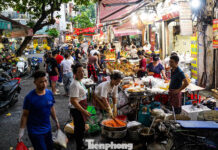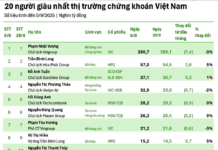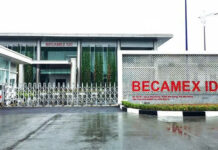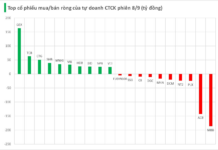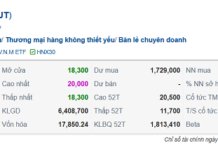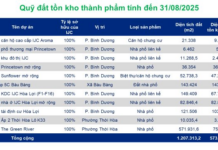The 3rd Ring Road through Dong Anh district has a total length of nearly 15km, starting at the intersection of the Hanoi – Thai Nguyen expressway and ending at Vo Van Kiet Street.
According to the plan, the road will pass through 9 communes in Dong Anh, including Lien Ha, Viet Hung, Uy No, Dong Anh town, Tien Duong, Van Noi, Nguyen Khe, Bac Hong, and Nam Hong. The total area of land to be acquired for the project is 130.8 hectares. Currently, the project area is mainly agricultural land, accounting for 95.4 hectares; urban residential land accounts for 9.7 hectares; rural residential land accounts for 0.7 hectares; and transport land accounts for 19.4 hectares…
In July 2023, the project for the 3rd Ring Road segment through Dong Anh was approved for investment by the Hanoi People’s Council, divided into two component projects, with component project 1 involving compensation, resettlement support, and land clearance.
The total investment for the compensation, resettlement support, and land clearance project for the 3rd Ring Road through Dong Anh is 2,406 billion VND, of which the compensation and support costs amount to 2,342 billion VND and the cost of technical infrastructure relocation is 41 billion VND.
For the construction and implementation of the road section, it will have a cross-section width of 68m and an estimated total investment of 5,413 billion VND. Thus, the total investment for both component projects of the 3rd Ring Road through Dong Anh is nearly 8,000 billion VND.
According to the approved investment plan, the 3rd Ring Road through Dong Anh will be implemented in the period 2023 – 2028.
In July 2023, the Hanoi People’s Council also approved the establishment of Dong Anh district and its constituent wards, based on the current natural area of 185.68 km2 and a population of 437,308 people in Dong Anh district. This will create 24 wards under Dong Anh district.
According to the orientation, Dong Anh district will be developed into a center for high-tech industry, services, finance, trade, and international transactions in the North of the Red River, playing a role as a driving force for development in the North of the capital city.
Dong Anh district is also traversed by 2 railway lines connecting Hanoi City center with Thai Nguyen province and Lao Cai province. Especially, the district is only 13km away from Noi Bai International Airport, which is considered a gateway for international trade and has given Dong Anh many advantages for all-round economic and social development.
In addition to the 3rd Ring Road project, in August 2023, Hanoi approved the investment in 10 other large-scale infrastructure projects in Dong Anh, including: Building the road connecting the new National Highway 3 to the Dong Anh People’s Committee to the end of Dong Anh (1.8km long, 40m wide, 278 billion VND); building the road from Hoang Sa to the Hanoi – Lao Cai railway (3.7km long, 50m wide, 1,239 billion VND).
Building the LK50 road section from the old National Highway 3 to Thu Lam Street (5.9km long, 50m wide, 1,303 billion VND); building the LK51 road section from the new National Highway 3 to Uy No (5.7km long, 40m wide, 1,168 billion VND).
Building the LK53 road section from the East Economic Corridor (West Bridgehead) to the end of Dong Anh district (1.3km long, 25-40m wide, 261 billion VND); building the LK54 road section connecting the Nhat Tan Resettlement Area to the LK53 road (3.8km long, 40m wide, 1,204 billion VND).
Building the LK47 road section from Nam Hong to Tien Duong, from Vo Nguyen Giap to Vo Van Kiet (4.5km long, 30-40m wide, 886 billion VND); building the road from Nguyen Khe Industrial Park to Phu Lien hamlet, Bac Hong commune (3.8km long, 25-40m wide, 662 billion VND).
Building the road from the Hanoi – Lao Cai railway to the Dong Anh Industrial Park (2.9km long, 50m wide, 601 billion VND); building the road from Loc Ha bridge to the Co Loa Resettlement Area (5.5km long, 40m wide, 960 billion VND).
As part of the process of upgrading to a district, Dong Anh district will also receive priority resources and development, especially the construction of major bridges connecting with the center of the capital. Among them, 3 trillion-dollar bridges crossing the Red River will be built, namely Tu Lien, Thuong Cat, and new Thang Long Bridge.
Accordingly, Tu Lien Bridge will have a total length of about 4.8km, designed to withstand earthquakes up to level 8. The bridge will have 8 lanes with a total investment of about 17,000 billion VND. It is expected to be the second cable-stayed bridge after Nhat Tan Bridge to be built in Hanoi and will commence construction in 2024.
Thuong Cat Bridge will overlap with the 3.5 Ring Road, crossing the residential area of Lien Mac – Thuong Cat (Bac Tu Liem) and connecting to the Thang Long Industrial Park (Dong Anh district) with 8 lanes and a total investment of about 8,300 billion VND. The project will be implemented within 4 years (2023 – 2027).
In addition, the new Thang Long Bridge will be located next to the current Thang Long Bridge, running along the 3rd Ring Road, with a length of 2km and expected to be built after 2030.
Aside from the aforementioned bridges, according to the master plan for the development of transportation in Cluster N9 and Cluster N10, another bridge could be built north across the Duong River, connecting Dong Anh with Long Bien district. The proposed location for the construction of this bridge is the section connecting Phuong Trach levee (near Dong Hoi ferry terminal, Dong Anh) to Ngoc Thuy Street (Long Bien district).
In mid-October, the Hanoi Department of Transportation announced that with the urban development plan on both sides of the river, extending to neighboring provinces in the capital region, the city will need more river-crossing bridges. Therefore, the Department proposed adding 4 more bridges across the Red River to enhance connectivity to certain urban areas as well as neighboring provinces. One bridge is proposed to be located on the 2.5 Ring Road to Dong Anh, connecting Phu Thuong Ward (Tay Ho district) to Hai Boi and Vinh Ngoc communes in Dong Anh district.
If this proposal is approved, Dong Anh district will have a total of 7 bridges crossing the Red River and Duong River, connecting Dong Anh with the central area and other districts of Hanoi. Currently, the district already has 3 major bridges connecting to the city center: Nhat Tan Bridge, Thang Long Bridge (crossing the Red River), and Dong Tru Bridge (crossing the Duong River).
Not only hosting major infrastructure projects, Dong Anh also attracts attention with the Super Smart City project that includes the tallest financial tower in Vietnam. This project is implemented by the BRG Joint Stock Company (Vietnam) and Sumitomo Group (Japan) under the joint venture BAC Hanoi Smart City Development Investment Corporation. With a total area of more than 270 hectares and an investment amounting to USD 4.2 billion, the project is located in Hai Boi, Vinh Ngoc, and Kim No communes.
The project includes a 108-story financial tower, listed as one of the pivotal works that has been resolved by the Hanoi People’s Council. This tower is the highlight and center of the project, expected to be the tallest tower in Vietnam and Southeast Asia.

Rendering of the 108-story financial tower of the smart city project. Photo: BRG.
In addition to this mega project, Dong Anh district also organized a public announcement of the 1/500 investment project planning document for the construction of the Dong Anh Administrative Center. This center is expected to be located in Uy No commune and Dong Anh town, with a land area of about 4.97 hectares, intended to be the “brain” center – the place for the urban government offices in Dong Anh in the coming years.
Furthermore, in the future, Dong Anh will become a district that gathers many national major projects, such as the 90-hectare National Exhibition Center project with a scale of 7,336 billion VND in Xuan Hoi and Xuan Canh; Vinhomes Co Loa project in Xuan Canh, Dong Hoi, Mai Lam communes with a scale of 34,879 billion VND; the TH Medical High-tech Healthcare and Care Center project in Tien Duong commune with an investment of 3,500 billion VND; the Kim Quy Park project located in Ngoc Chi hamlet, Vinh Ngoc commune, with an area of 190 hectares and a scale of 4,600 billion VND, etc.



